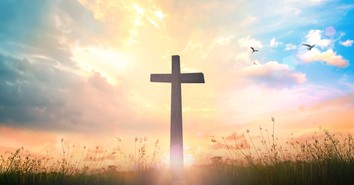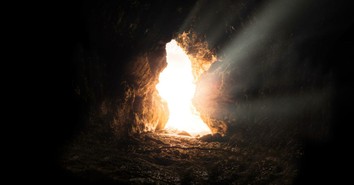What Cleopas Teaches Us About Finding Jesus in the Darkest Moments

Cleopas doesn’t appear in a big Bible story, but the story he’s mentioned in is one of the most famous stories about Jesus’ activities after the resurrection. Meeting Jesus in the last place he expected, Cleopas learned things he never expected about the Messiah, death, and life.
Who Was Cleopas in the Bible?
There are two men mentioned in the Gospels called Cleopas. John 19:25 mentions that Jesus had an aunt, “Mary the wife of Cleopas” who was present at the crucifixion, although the Gospels don’t give definitive evidence that it’s the same person.
The more famous Cleopas is mentioned in Luke 14:13-25. On Sunday, two days after Jesus’ death and placement in a tomb, the women went to anoint Jesus’ body as part of traditional burial customs. They found his body gone, the tomb empty (and depending on which Gospel you read, one or several angels at the scene). The women went to the disciples and relayed what the angels had told them: Jesus was risen from the dead. This being a shocking idea (especially for Jewish audiences who believed that bodies didn’t get resurrected until the end of days), the disciples didn’t understand this. Peter went to check out the scene for himself and found it empty as the women said, but apparently not sure what he thought.
On the same day (apparently, after the news of these strange things had gotten around to Jesus’ various followers), two men who had followed Jesus were traveling from Jerusalem to a village called Emmaus. Jesus appeared; the two men did not know who he was, and he asked them why they were troubled. One of them (now identified as Cleopas) told this stranger about Jesus’ death, how it had shocked them, and how the women had found the tomb empty that morning. Cleopas ends his explanation by adding, “some of our companions went to the tomb and found it just as the women had said, but they did not see Jesus” (Luke 24:24). This suggests skepticism or at least confusion on Cleopas’ part—he’s still not sure what to think about the body’s disappearance, not ready to believe in a bodily resurrection.
Jesus told Cleopas and his friend that they didn’t understand the ancient prophecies which stated that the Messiah had to suffer. He continued walking with them and explained all the relevant Old Testament passages to them, backing up his point. This conversation continued until they reached Emmaus, where Cleopas and his friend convinced Jesus to stay with them that night. At dinner in their abode, Jesus broke bread and prayed for it, and “then their eyes were opened and they recognized him, and he disappeared from their sight” (Luke 24:31).
Cleopas and his friend talked about how Jesus’ words had affected them while they walked, and they quickly left to return to Jerusalem. They met with the disciples about what had happened, and during that same meeting, Jesus appeared and showed that he was not a ghost (Luke 24:36-49).
Why Didn't Cleopas Recognize Jesus on the Road to Emmaus?
Luke writes that when Jesus appeared to Cleopas and his friend, “they were kept from recognizing him” (Luke 24:16), and later “their eyes were opened and they recognized him” (Luke 24:31). This is similar to the scene in John where Mary Magdalene is at Jesus’ empty tomb, and “she turned around and saw Jesus standing there, but she did not realize that it was Jesus” (John 20:14). Mary Magdalene realizes who she’s speaking to after Jesus says her name and calls him “teacher!” (John 20:16).
Both stories seem to suggest that either Jesus didn’t look like he did before the resurrection, or that in some way God was keeping their eyes from seeing who it was. Given that Jesus seems to have new powers after the resurrection (appearing inside locked rooms and disappearing, ascending into the clouds), it’s possible that he could have physically changed his appearance back and forth. However, the emphasis on eyes being opened suggests that it was some spiritual force being directed on the recipient (Mary Magdalene, Cleopas, and his friend). Either way, it’s a mysterious process that is never outlined exactly.
What Happened to Cleopas after Emmaus?
The Bible doesn’t mention Cleopas after this Emmaus event, which makes it hard or impossible to say what happened to him.
As noted above, Mary the wife of Cleopas is listed as the sister of Jesus’ mother, Mary. This would make the Cleopas mentioned in John an uncle of Jesus. An early church historian, Eusebius of Caesarea, cites some information about this Cleopas’ family in Chapter 11, Book 3 of his Church Histories (information he apparently got from another historian, Hegesippus). Eusebius writes that this Cleopas had a son named Simeon, who became a leader over the church in Jerusalem, partly because of he was “a cousin of the Savior.”
At least three denominations have special feast days in their church calendars that commemorate the Cleopas who met Jesus en route to Emmaus. The Greek Orthodox Church celebrates the feast of Cleopas and Artemas on October 30, Roman Catholic Church celebrates him on September 25, and the Coptic Orthodox Church on November 10. These denominations all have varying opinions set down on whether the two men named Cleopas are separate or the same man.
4 Important Lessons from Cleopas and the Road to Emmaus Story
Cleopas is a fascinating figure for many reasons, and we could learn a lot from him. Here are four specific things we can all learn from his situation:
Recognize there may be hope where we least expect it. One thing that stands out very clearly about Cleopas’ words is that he and others were disappointed at Jesus’ death. Their hope in the Messiah had died with Jesus’ death, and then they had to recalibrate when it turned out that Jesus had risen. While none of us will be in a situation exactly like Cleopas, we will all have times when our hope gets crushed and all seems lost. In those moments, we have to recognize that God is still active, and hope is still possible.
Be prepared to admit when your expectations were wrong. Cleopas emphasizes that he and others were shocked at Jesus’ death because “we had hoped that he was the one who was going to redeem Israel” (Luke 24:21). This is a recurring theme in the Gospels—Jesus mentioned multiple times that in Jerusalem he would be killed and rise again, and each time the disciples are described as denying this would happen or not being sure what he meant. We can’t help when we were born or what cultural factors affect our perceptions. However, we can recognize how those things affect us and admit when our idea of how things are supposed to go is mistaken.
Be prepared to admit when you haven’t done your homework. It’s interesting that when Jesus tells Cleopas and his friend how mistaken he was, he highlights how Scripture had predicted Jesus’ death was going to take place. While Jesus talked about using riddles to keep people from understanding some of his teachings (Mark 4:11-12), he seems to maintain that his disciples could have known from studying Scripture what was going to happen.
Develop a familiarity of when the spirit is moving. Christians debate the extent to which the Holy Spirit speaks to us individually, and what that process looks like. However, the Bible affirms that the Holy Spirit does communicate to individuals at least sometimes—for example, in Acts 16:6 when the spirit keeps Paul from preaching in particular cities. Arguably, we also see this in Cleopas’ story when he comments to his friend about how their hearts were burning as Jesus spoke to them (Luke 24:32). Hearing Scripture taught to them, confirming something they had seen hints of, registered with them on a spiritual level. We will always be flawed human beings on this side of heaven, so there will always be a possibility that we misunderstand what the Spirit is saying to us (hence why looking to Scripture for confirmation is important). However, we still benefit by learning to pay attention to the Spirit, looking for those moments when our hearts burn because an important truth is being relayed.
Photo Credit: ©iStock/Getty Images Plus/Mimadeo

Originally published November 08, 2021.





